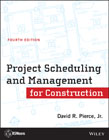
First published in 1988 by RS Means, the new edition of Project Scheduling and Management for Construction has been substantially revised for students enrolled in construction management and civil engineering programs. While retaining its emphasis on developing practical, professional–level scheduling skills, the new edition is a relatable, real–world case study that can be used over the course of a semester. The book also includes classroom elements like exercises, quizzes, skill–building exercises, as well as an instructor?s manual including two additional new cases. INDICE: Preface xi Introduction xiii Chapter 1 Project Management Fundamentals 3 What Is Management in General? 3 What Is Project Management? 4 Why Use Project Management? 7 The Benefits 8 Variables That Affect the Project 10 The Project Control Cycle 11 Introduction to CPM Scheduling 14 Introduction to the Sample Building Project 17 Summary 18 Review Questions 18 Chapter 2 Preplanning Investigation 23 Identifying Key Personnel 24 Providing Data to the Project Team 24 Contract Document Review 24 Estimate Review/Estimator Meeting 26 Initial Project Team Meeting 28 Preplanning with Other Parties 29 Summary 34 Review Questions 34 Chapter 3 Planning the Project 39 Breaking the Job Down into Activities 39 Establishing the Sequence of Work 51 Summary 59 Practice Logic Problems 60 Chapter 4 Scheduling the Project 67 Estimating Durations 67 Actual Calculation of Activity Durations 70 Calculating Overall Job Duration 75 Advanced Calculations 84 Calendars 87 Summary 88 Practice Problems 89 Chapter 5 Publishing the Schedule 93 Checking the Final Schedule 93 Key Questions to Ask 95 Tasks That Must Be Performed in Order to Provide the Right Information 96 Types of Coding Schemes 96 Sample Reports: Office Building 101 Summary 102 Review Questions 111 Chapter 6 Monitoring and Controlling the Project 115 The Monitoring Process 115 Monitoring Progress 117 Taking Corrective Action 126 Update Problem Example 128 Summary 130 Review Questions 132 Chapter 7 Resource Management 135 How to Manage Resources 135 The Resource Management Process 136 Development of the Resource Profile 137 Adjusting the Schedule to Improve the Resource Curve 140 Practical Aspects of Resource Management 144 Other Applications: Earned Value 144 Other Applications: Cost ]Loaded Schedules 152 Summary 153 Review Questions 153 Chapter 8 Procurement Scheduling 157 The Source of the Problem 157 Basic Procurement Procedures 158 Key Elements in Successful Procurement 159 Record Keeping and Tracking 160 Issues with Scheduling Procurement Activities 166 Reporting 166 Follow Up on the Information 167 Summary 167 Review Questions 167 Chapter 9 Line of Balance Scheduling 171 When to Use Line of Balance Scheduling 171 General Technique 172 Example Problem 175 Updating a Line of Balance Schedule 187 Review Questions 190 Practice Problems 190 Chapter 10 Project Cost Control 195 Project Cost Coding Systems 196 Specific Tasks in Project Cost Control 200 Other Cost Control Issues 213 Appendix A Vehicle Maintenance Facility Drawings 217 Appendix B Vehicle Maintenance Facility: Activities, Logic, Codes, and Cost Data 239 Appendix C Notes on Schedule Sequencing 247 Index 253
- ISBN: 978-1-118-36780-3
- Editorial: John Wiley & Sons
- Encuadernacion: Rústica
- Páginas: 272
- Fecha Publicación: 21/11/2013
- Nº Volúmenes: 1
- Idioma: Inglés
